Historian John Loeper tells a crowd in December at the U.S. Life Saving Station that there is much to be learned about the Sindia.
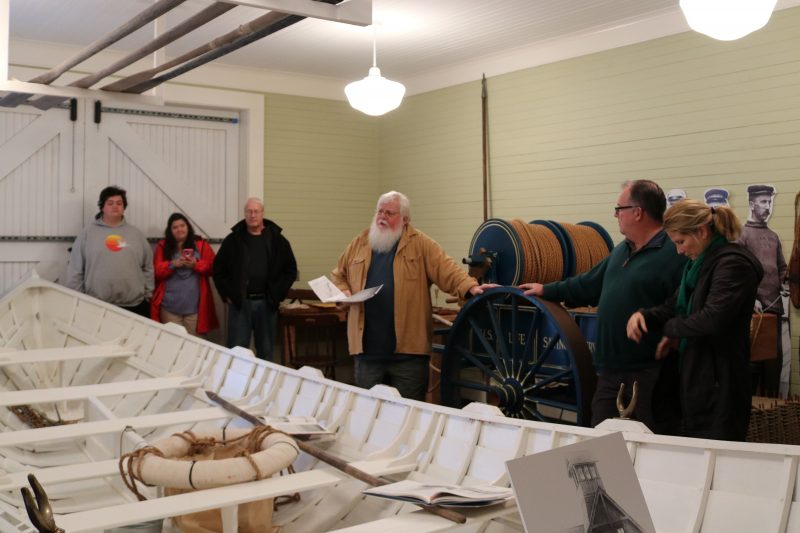 By Maddy Vitale
Historian John Loeper led a group of about 40 people into a room in the U.S. Life Saving Station in Ocean City on Saturday morning.
They gathered around a 26-foot lifeboat. It was a replica of the one six men dragged to the ocean using thick hemp ropes to rescue the stranded crew members off the Sindia shipwreck 117 years ago.
The Sindia, filled with cargo from Asia, ran aground between 16th and 17th streets during a heavy storm while en route to the New York harbor Dec. 15, 1901. It broke apart, but pieces of the wreck remained visible through the 1980s.
The Sindia was a 329-foot sailing cargo ship. Its size and the year it dates from -- about 1887 -- are no mysteries.
By Maddy Vitale
Historian John Loeper led a group of about 40 people into a room in the U.S. Life Saving Station in Ocean City on Saturday morning.
They gathered around a 26-foot lifeboat. It was a replica of the one six men dragged to the ocean using thick hemp ropes to rescue the stranded crew members off the Sindia shipwreck 117 years ago.
The Sindia, filled with cargo from Asia, ran aground between 16th and 17th streets during a heavy storm while en route to the New York harbor Dec. 15, 1901. It broke apart, but pieces of the wreck remained visible through the 1980s.
The Sindia was a 329-foot sailing cargo ship. Its size and the year it dates from -- about 1887 -- are no mysteries.
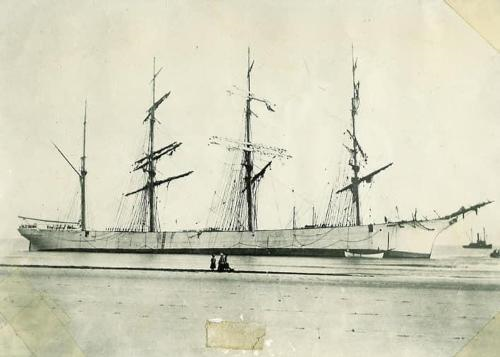
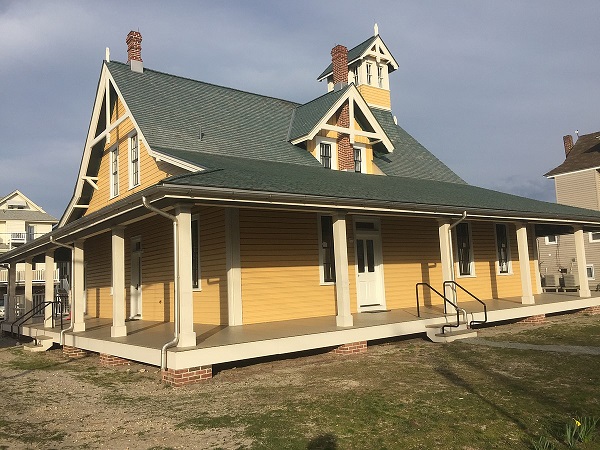 U.S. Life Saving Station 30, where surfmen were dispatched to save the crew members of the Sindia.
The crowd listening to Loeper asked him a host of questions, including the contents of the ship’s cargo, claims of silver, how big the Sindia was, and why it hasn’t been brought to the surface. Loeper answered the questions and also gave them interesting tidbits that he said he hopes will some day lead to a book.
There is still an open insurance claim involving the captain’s assertion that there was precious cargo that belonged to him lost in the Sindia wreck, Loeper told the crowd. He said he could not elaborate because of a disclosure clause with the insurance company.
Throughout what was an eight or nine month journey, the Sindia traveled in areas possibly outside of the normal routes taken by other sailing vessels of the time. One of the reasons could have been that the Sindia, with its contents, was trying to avoid detection.
“It was sighted just once,” he noted.
At the time of the sinking, the ship was owned by John D. Rockefeller’s Standard Oil Company. Loeper believes that the Sindia carried all sorts of contraband from silver and gold coins to valuable pieces looted from China.
The ship's captain, Allan MacKenzie, was admonished for putting the Sindia on the beach.
“There was something he was bringing in,” Loeper said.
Knowing that Ocean City, unlike a New York harbor, would not exactly garner a lot of publicity, the captain decided to “park it there,” Loeper maintained.
U.S. Life Saving Station 30, where surfmen were dispatched to save the crew members of the Sindia.
The crowd listening to Loeper asked him a host of questions, including the contents of the ship’s cargo, claims of silver, how big the Sindia was, and why it hasn’t been brought to the surface. Loeper answered the questions and also gave them interesting tidbits that he said he hopes will some day lead to a book.
There is still an open insurance claim involving the captain’s assertion that there was precious cargo that belonged to him lost in the Sindia wreck, Loeper told the crowd. He said he could not elaborate because of a disclosure clause with the insurance company.
Throughout what was an eight or nine month journey, the Sindia traveled in areas possibly outside of the normal routes taken by other sailing vessels of the time. One of the reasons could have been that the Sindia, with its contents, was trying to avoid detection.
“It was sighted just once,” he noted.
At the time of the sinking, the ship was owned by John D. Rockefeller’s Standard Oil Company. Loeper believes that the Sindia carried all sorts of contraband from silver and gold coins to valuable pieces looted from China.
The ship's captain, Allan MacKenzie, was admonished for putting the Sindia on the beach.
“There was something he was bringing in,” Loeper said.
Knowing that Ocean City, unlike a New York harbor, would not exactly garner a lot of publicity, the captain decided to “park it there,” Loeper maintained.
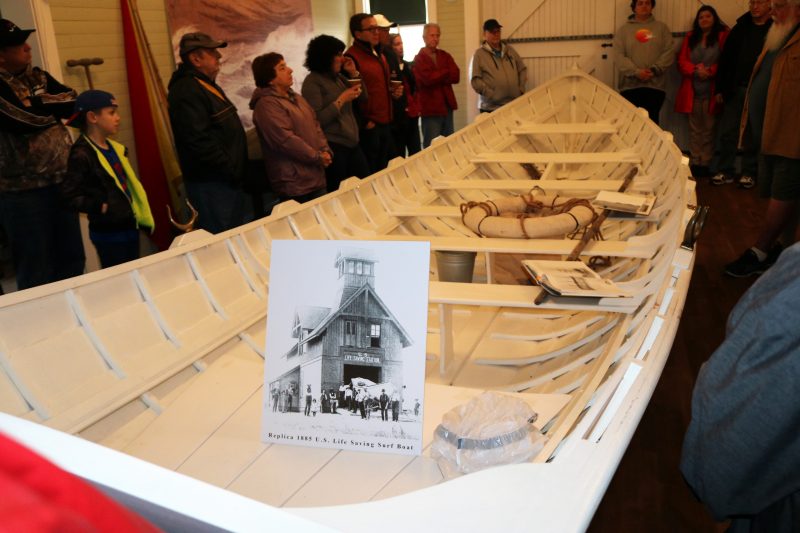 The postcard displays the U.S. Life Saving station crew circa 1885 taking out a lifeboat like this one on display.
While no one died in the wreck of the Sindia, the Life Saving station men had to rescue the crew members and bring them safely ashore. Now, the wreck is buried under at least eight feet of sand.
At the turn of the century, the station, one of 480 in existence back then, made about four rescues a month, Loeper said. About 100 sailboats traveled the waterways along Ocean City a day. The men in the station received $40 a month for their work. Most worked there after making a living doing something on the water.
Most vessels in that time period would follow the lighthouses lining the coast, each with its own distinguishable beacon from Ocean City to Sea Isle City to Hereford Inlet to Cape May, he said.
Christopher Homme, who has lived in Ocean City for 30 years, called Loeper's presentation on the Sindia very informative.
“This talk was interesting. It is so important for the local people to learn about the Sindia,” Homme said.
The postcard displays the U.S. Life Saving station crew circa 1885 taking out a lifeboat like this one on display.
While no one died in the wreck of the Sindia, the Life Saving station men had to rescue the crew members and bring them safely ashore. Now, the wreck is buried under at least eight feet of sand.
At the turn of the century, the station, one of 480 in existence back then, made about four rescues a month, Loeper said. About 100 sailboats traveled the waterways along Ocean City a day. The men in the station received $40 a month for their work. Most worked there after making a living doing something on the water.
Most vessels in that time period would follow the lighthouses lining the coast, each with its own distinguishable beacon from Ocean City to Sea Isle City to Hereford Inlet to Cape May, he said.
Christopher Homme, who has lived in Ocean City for 30 years, called Loeper's presentation on the Sindia very informative.
“This talk was interesting. It is so important for the local people to learn about the Sindia,” Homme said.
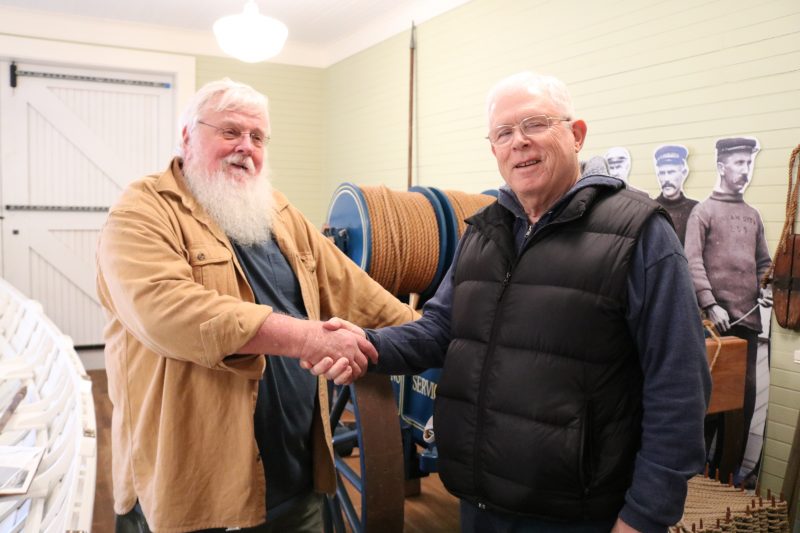 John Loeper talks with Christopher Homme, of Ocean City, after the presentation.
Ocean City residents Marla Janor and her husband, Ernie Ritacco, attended the presentation because they wanted to learn more about the Sindia and the Life Saving Station.
“I learned some really interesting things today,” Janor said.
Pieces from the Sindia, including porcelain and other relics, may be viewed at the Ocean City Historical Museum.
Loeper said in his 35 years or so of researching the Sindia, there is a lot that he still wants to figure out. There are certain beliefs about the shipwreck and its contents that must be separated as fact or fiction, he explained.
He said this was the first of many presentations he hopes to give on the Sindia at the Life Saving Station to keep the ship's history alive.
“If the story of the Sindia is not told in this generation, it will be totally lost,” Loeper said.
The U.S. Life Saving Station is located at 801 E. 4th Street. For more information visit the Ocean City Historical Museum, call (609) 399-1801 or visit www.ocnjmuseum.org. The museum is housed inside the Ocean City Community Center, 1735 Simpson Ave.
John Loeper talks with Christopher Homme, of Ocean City, after the presentation.
Ocean City residents Marla Janor and her husband, Ernie Ritacco, attended the presentation because they wanted to learn more about the Sindia and the Life Saving Station.
“I learned some really interesting things today,” Janor said.
Pieces from the Sindia, including porcelain and other relics, may be viewed at the Ocean City Historical Museum.
Loeper said in his 35 years or so of researching the Sindia, there is a lot that he still wants to figure out. There are certain beliefs about the shipwreck and its contents that must be separated as fact or fiction, he explained.
He said this was the first of many presentations he hopes to give on the Sindia at the Life Saving Station to keep the ship's history alive.
“If the story of the Sindia is not told in this generation, it will be totally lost,” Loeper said.
The U.S. Life Saving Station is located at 801 E. 4th Street. For more information visit the Ocean City Historical Museum, call (609) 399-1801 or visit www.ocnjmuseum.org. The museum is housed inside the Ocean City Community Center, 1735 Simpson Ave.